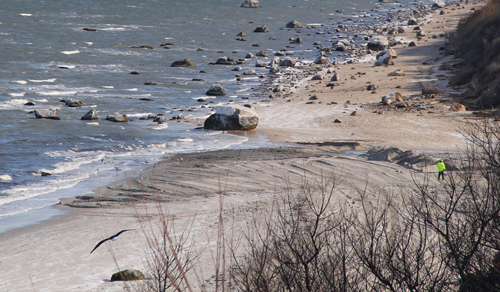Project to dredge Mattituck Inlet extended another week

Ron McGreevy has pushed for more than a decade for the dredging of Mattituck Inlet. So naturally, he’s been keeping a watchful eye on the project, which started Jan. 21.
Recently, Mr. McGeevy noticed that the amount of sand the U.S. Army Corps of Engineers had promised for the shore-starved homeowners on the inlet’s eastern side — when compared with his measurements of the newly replenished beach — simply weren’t adding up.
With measuring tape in hand, Mr. McGreevy has been braving the cold and whipping winds to try to make sense of the disparity, which he had noticed happening early on in the project.
This, as a Feb. 28 deadline imposed by the state Department of Environmental Conservation permit loomed.
The $2.2 million dredging project, which federal officials had said was on schedule for completion during a Feb. 2 press conference at the inlet, has since been extended by one week, to March 7 after the DEC granted a permit extension to continue to dredge.
“We basically pushed the Corps to do this to ensure that the proper amount of material would get put on the shore,” Congressman Tim Bishop (D-Southampton) said in an interview Thursday. “It became clear the week of Feb. 7 that it was going to be very hard to reach that goal.”
Mr. Bishop, who was at the Feb. 2 press conference, had worked to get the project approved for federal funding.
Homeowners on the east side of Mattituck Inlet, which includes Mr. McGreevy, had long been awaiting the dredging project — which was planned to bring with it a beach re-nourishment of about 100,000 cubic yards of dredging material, some of which was to be removed from the inlet, deepening the inlet channel to 11 feet below mean low tide, improving navigability.
But it looks as if homeowners on the east side won’t be getting the full re-nourishment they might have anticipated.
Chris Gardner, an Army Corps of Engineers spokesman, said this week that, “When all is said and done we would estimate there will be around 90,000 cubic yards, give or take, that stays in the project area, which is in line with given estimates.”
Mr. Bishop said engineers found “there simply was not enough material in the inlet at the depth and width they had previously been authorized to do.”
To provide homeowners with the amount of sand they were promised, within those estimates, engineers are dredging the inlet three feet deeper than originally planned — to a depth of about 14 feet below mean low tide, Mr. Bishop said.
He added that some of the sand pumped to the nearby shore was very fine, and drifted away once pumped over.
Mr. Gardner said engineers have pumped more than 100 cubic yards onto the shore, but “all of that obviously is not staying, and that is to be expected.”
The dredged sand is being placed on the beach to the east of the inlet in the form of a 20-foot-wide strip about 4,500 feet long starting at the eastern jetty, according to Mr. Bishop’s office.
Mr. Bishop said “the navigation of the inlet should be dramatically improved for a long time given the extended depth, and I am hopeful that we are going to get as close to 100,000 as possible. If we are at 90,000 or 95,000 it will still provide a good level of protection.”
He added that he is thankful that the Army Corps and the DEC were “as responsive as they were, and that they continued to work on the project.”







